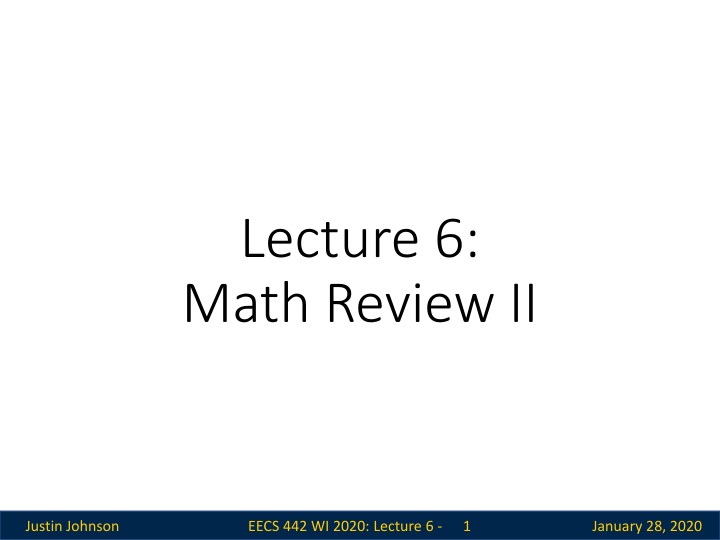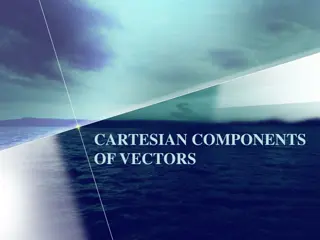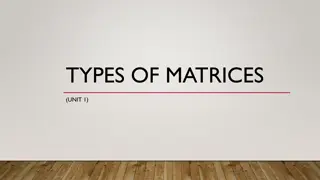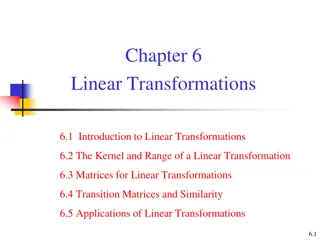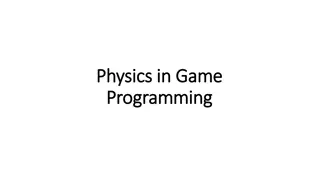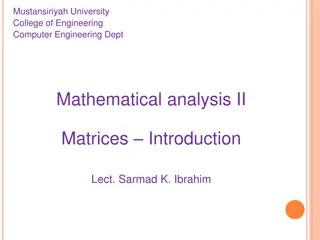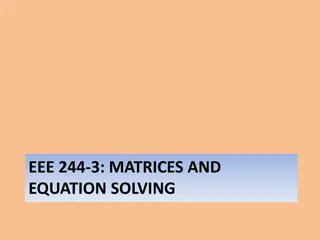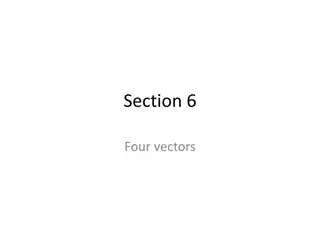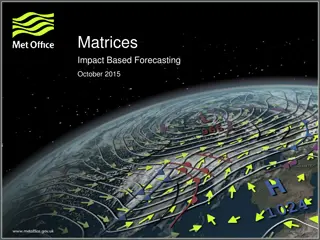Math Fundamentals: Matrices and Vectors in EECS 442
Delve into the world of matrices and vectors with a focus on floating-point math, IEEE standards, vector operations, and matrix manipulation in the context of EECS 442 lectures by Justin Johnson. Explore foundational concepts such as concatenation, transpose, cross product, dot product, and the nuances of working with vectors of different sizes.
Download Presentation

Please find below an Image/Link to download the presentation.
The content on the website is provided AS IS for your information and personal use only. It may not be sold, licensed, or shared on other websites without obtaining consent from the author.If you encounter any issues during the download, it is possible that the publisher has removed the file from their server.
You are allowed to download the files provided on this website for personal or commercial use, subject to the condition that they are used lawfully. All files are the property of their respective owners.
The content on the website is provided AS IS for your information and personal use only. It may not be sold, licensed, or shared on other websites without obtaining consent from the author.
E N D
Presentation Transcript
Lecture 6: Math Review II Justin Johnson 1 January 28, 2020 EECS 442 WI 2020: Lecture 6 -
Administrative HW0 due tomorrow, 1/29 11:59pm HW1 due 1 week from tomorrow, 2/5 11:59pm Justin Johnson 2 January 28, 2020 EECS 442 WI 2020: Lecture 6 -
Last Time: Floating Point Math IEEE 754 Single Precision / Single / float32 8 bits 2127 1038 23 bits 7 decimal digits S Exponent Fraction IEEE 754 Double Precision / Double / float64 11 bits 21023 10308 52 bits 15 decimal digits Exponent Fraction S Justin Johnson 3 January 28, 2020 EECS 442 WI 2020: Lecture 6 -
Last Time: Vectors Scale (vector, scalar vector) Add (vector, vector vector) Magnitude (vector scalar) Dot product (vector, vector scalar) Dot products are projection / angles Cross product (vector, vector vector) Vectors facing same direction have cross product 0 0 You can never mix vectors of different sizes Justin Johnson 4 January 28, 2020 EECS 442 WI 2020: Lecture 6 -
Matrices Justin Johnson 5 January 28, 2020 EECS 442 WI 2020: Lecture 6 -
Matrices Horizontally concatenate n, m-dim column vectors and you get a mxn matrix A (here 2x3) ?11 ?12 ?21 ?22 ?31 ?32 ? = ?1, ,?? = (scalar) lowercase undecorated (vector) lowercase bold or arrow (matrix) uppercase bold a a A Justin Johnson 6 January 28, 2020 EECS 442 WI 2020: Lecture 6 -
Matrices Horizontally concatenate n, m-dim column vectors and you get a mxn matrix A (here 2x3) ?11 ?12 ?21 ?22 ?31 ?32 ? = ?1, ,?? = Watch out: In math, it s common to treat D-dim vector as a Dx1 matrix (column vector); In numpy these are different things Justin Johnson 7 January 28, 2020 EECS 442 WI 2020: Lecture 6 -
Matrices ? ? ? ? Transpose: flip rows / columns (3x1)T= 1x3 = ? ? ? Vertically concatenate m, n-dim row vectors and you get a mxn matrix A (here 2x3) ? ?1 ?? ?11 ?21 ?12 ?22 ?13 ?23 ? = = ? Justin Johnson 8 January 28, 2020 EECS 442 WI 2020: Lecture 6 -
Matrix-vector Product ?2?1= ?2?3?3?1 ?1 ?2 ?3 ?1 ?2 = ?? ?? ?? ? = ?1??+ ?2??+ ?3?? Linear combination of columns of A Justin Johnson 9 January 28, 2020 EECS 442 WI 2020: Lecture 6 -
Matrix-vector Product ?2?1= ?2?3?3?1 3 ?1 ?2 ? ? ?? ? = 3 ?? ?? ?? ?1= ?? ?2= ?? Dot product between rows of A and x Justin Johnson 10 January 28, 2020 EECS 442 WI 2020: Lecture 6 -
Matrix Multiplication Generally: Amn and Bnp yield product (AB)mp | | ? ?? ?? ?? | ?? | ?? = ? Yes in A, I m referring to the rows, and in B, I m referring to the columns Justin Johnson 11 January 28, 2020 EECS 442 WI 2020: Lecture 6 -
Matrix Multiplication Generally: Amn and Bnp yield product (AB)mp | | ??? ????= ?? ?? | ?? | ??? ?? ??? ?? ? ?? ?? ?? ?? ?? = ? ??? ??? Justin Johnson 12 January 28, 2020 EECS 442 WI 2020: Lecture 6 -
Matrix Multiplication Dimensions must match Dimensions must match Dimensions must match (Associative): ABx = (A)(Bx) = (AB)x (Not Commutative): ABx (BA)x (BxA) Justin Johnson 13 January 28, 2020 EECS 442 WI 2020: Lecture 6 -
Two uses for Matrices 1. Storing things in a rectangular array (e.g. images) Typical operations: element-wise operations, convolution (which we ll cover later) Atypical operations: almost anything you learned in a math linear algebra class 2. A linear operator that maps vectors to another space (Ax) Typical/Atypical: reverse of above Justin Johnson 14 January 28, 2020 EECS 442 WI 2020: Lecture 6 -
Images as Matrices Suppose someone hands you this matrix. What s wrong with it? No contrast! Justin Johnson 15 January 28, 2020 EECS 442 WI 2020: Lecture 6 -
Contrast: Gamma Curve Typical way to change the contrast is to apply a nonlinear correction pixelvalue? The quantity ? controls how much contrast gets added Justin Johnson 16 January 28, 2020 EECS 442 WI 2020: Lecture 6 -
Contrast: Gamma Curve Now the darkest regions (10th pctile) are much darker than the moderately dark regions (50th pctile). 90% 50% new 90% 10% new 50% new 10% Justin Johnson 17 January 28, 2020 EECS 442 WI 2020: Lecture 6 -
Contrast: Gamma Correction Justin Johnson EECS 442 WI 2020: Lecture 6 - 18 January 28, 2020
Contrast: Gamma Correction Phew! Much Better. Justin Johnson EECS 442 WI 2020: Lecture 6 - 19 January 28, 2020
Implementation Python+Numpy (right way): imNew = im**4 Python+Numpy (slow way why? ): imNew = np.zeros(im.shape) for y in range(im.shape[0]): for x in range(im.shape[1]): imNew[y,x] = im[y,x]**expFactor Justin Johnson 20 January 28, 2020 EECS 442 WI 2020: Lecture 6 -
Elementwise Operations Element-wise power beware notation ? ?? ??= ??? Hadamard Product / Element-wise multiplication ? ???= ??? ??? Element-wise division ?/???=??? ??? Justin Johnson 21 January 28, 2020 EECS 442 WI 2020: Lecture 6 -
Sums Across Axes ?1 ?? ?1 ?? ?1+ ?1 Suppose have Nx2 matrix A ? = (?,1) = ND col. vec. ??+ ?? ? ? (?,0) = ?? , ?? 2D row vec ?=1 ?=1 Note libraries distinguish between N-D column vector and Nx1 matrix. Justin Johnson EECS 442 WI 2020: Lecture 6 - 22 January 28, 2020
Operations they dont teach You Probably Saw Matrix Addition ? + ? ? + ? ? + ? ? + ? ? ? = ? ? ? ?+ What is this? FYI: e is a scalar ? + ? ? + ? ? + ? ? + ? ? ? ? ?+ ? = Justin Johnson 23 January 28, 2020 EECS 442 WI 2020: Lecture 6 -
Broadcasting If you want to be pedantic and proper, you expand e by multiplying a matrix of 1s (denoted 1) =? ? ?+ ?2?2? ? ? ? ?+ ? ? ? ?+? ? ? =? ? ? Many smart matrix libraries do this automatically. This is the source of many bugs. Justin Johnson 24 January 28, 2020 EECS 442 WI 2020: Lecture 6 -
Broadcasting Example Given: a nx2 matrix P and a 2D column vector v, Want: nx2 difference matrix D ?1 ?? ?1 ?? ?1 ? ?? ? ?1 ? ?? ? ? ? ? = ? = ? = ?1 ?? ?1 ?? Blue stuff is assumed / broadcast ? ? ? ??= ? ? Justin Johnson 25 January 28, 2020 EECS 442 WI 2020: Lecture 6 -
Broadcasting Rules Suppose we have numpy arrays x and y. How will they broadcast? 1. Write down the shape of each array as a tuple of integers: For example: x: (10,) y: (20, 10) 2. If they have different numbers of dimensions, prepend with ones until they have the same number of dimensions For example: x: (10,) y: (20, 10) x: (1, 10) y: (20, 10) 3. Compare each dimension. There are 3 cases: (a) Dimension match. Everything is good (b) Dimensions don t match, but one is =1. Duplicate the smaller array along that axis to match (c) Dimensions don t match, neither are =1. Error! Justin Johnson 26 January 28, 2020 EECS 442 WI 2020: Lecture 6 -
Broadcasting Examples x = np.ones(10, 20) y = np.ones(20) z = x + y print(z.shape) (10,20) x = np.ones(10, 20) y = np.ones(10) z = x + y print(z.shape) ERROR x = np.ones(10, 20) y = np.ones(10, 1) z = x + y print(z.shape) (10,20) x = np.ones(1, 20) y = np.ones(10, 1) z = x + y print(z.shape) (10,20) Justin Johnson 27 January 28, 2020 EECS 442 WI 2020: Lecture 6 -
Tensors Scalar: Just one number Vector: 1D list of numbers Matrix: 2D grid of numbers Tensor: N-dimensional grid of numbers (Lots of other meanings in math, physics) Justin Johnson 28 January 28, 2020 EECS 442 WI 2020: Lecture 6 -
Broadcasting with Tensors The same broadcasting rules apply to tensors with any number of dimensions! x = np.ones(30) y = np.ones(20, 1) z = np.ones(10, 1, 1) w = x + y + z print(w.shape) (10, 20, 30) Justin Johnson 29 January 28, 2020 EECS 442 WI 2020: Lecture 6 -
Vectorization Writing code without explicit loops: use broadcasting, matrix multiply, and other (optimized) numpy primitives instead Justin Johnson 30 January 28, 2020 EECS 442 WI 2020: Lecture 6 -
Vectorization Example Suppose I represent each image as a 128- dimensional vector I want to compute all the pairwise distances between {x1, , xN} and {y1, , yM} so I can find, for every xi the nearest yj Identity: ? ?2= ?2+ ?2 2??? Or: ? ?= ? 2+ ? 2 2???1/2 Justin Johnson 31 January 28, 2020 EECS 442 WI 2020: Lecture 6 -
Vectorization Example ?1 ?? ?1 ?? | | ??= ?1 | ?? | ? = ? = ? ?? Compute a Nx1 vector of norms (can also do Mx1) ? ??,? = ? ?? Compute a NxM matrix of dot products ??? ??? ??= ?? Justin Johnson 32 January 28, 2020 EECS 442 WI 2020: Lecture 6 -
Vectorization Example 1/2 ? 2??? ? = ??,1 + ??,1 ? ?? ? ? + ?1 ?? ? ?? 2+ ?? 2+ ?? 2 2+ ?? 2+ ?? 2 ?? ?? Why? 2 2 ?? ?? 2 ?2,1 + ?2,1? 2+ ?? ??= ?? Justin Johnson 33 January 28, 2020 EECS 442 WI 2020: Lecture 6 -
Vectorization Example 1/2 ? 2??? ? = ??,1 + ??,1 2+ 2??? 2+ ?? ???= ?? Numpy code: XNorm = np.sum(X**2,axis=1,keepdims=True) YNorm = np.sum(Y**2,axis=1,keepdims=True) D = (XNorm+YNorm.T-2*np.dot(X,Y.T))**0.5 Get in the habit of thinking about shapes as tuples. Suppose X is (N, D), Y is (M, D): Justin Johnson 34 January 28, 2020 EECS 442 WI 2020: Lecture 6 -
Vectorization Example 1/2 ? 2??? ? = ??,1 + ??,1 2+ 2??? 2+ ?? ???= ?? (N, 1) Numpy code: XNorm = np.sum(X**2,axis=1,keepdims=True) YNorm = np.sum(Y**2,axis=1,keepdims=True) D = (XNorm+YNorm.T-2*np.dot(X,Y.T))**0.5 Get in the habit of thinking about shapes as tuples. Suppose X is (N, D), Y is (M, D): Justin Johnson 35 January 28, 2020 EECS 442 WI 2020: Lecture 6 -
Vectorization Example 1/2 ? 2??? ? = ??,1 + ??,1 2+ 2??? 2+ ?? ???= ?? (N, 1) (M, 1) Numpy code: XNorm = np.sum(X**2,axis=1,keepdims=True) YNorm = np.sum(Y**2,axis=1,keepdims=True) D = (XNorm+YNorm.T-2*np.dot(X,Y.T))**0.5 Get in the habit of thinking about shapes as tuples. Suppose X is (N, D), Y is (M, D): Justin Johnson 36 January 28, 2020 EECS 442 WI 2020: Lecture 6 -
Vectorization Example 1/2 ? 2??? ? = ??,1 + ??,1 2+ 2??? 2+ ?? ???= ?? (N, 1) (M, 1) (N, M) Numpy code: XNorm = np.sum(X**2,axis=1,keepdims=True) YNorm = np.sum(Y**2,axis=1,keepdims=True) D = (XNorm+YNorm.T-2*np.dot(X,Y.T))**0.5 Get in the habit of thinking about shapes as tuples. Suppose X is (N, D), Y is (M, D): Justin Johnson 37 January 28, 2020 EECS 442 WI 2020: Lecture 6 -
Vectorization Example 1/2 ? 2??? ? = ??,1 + ??,1 2+ 2??? 2+ ?? ???= ?? (N, 1) (M, 1) (N, M) (N, M) Numpy code: XNorm = np.sum(X**2,axis=1,keepdims=True) YNorm = np.sum(Y**2,axis=1,keepdims=True) D = (XNorm+YNorm.T-2*np.dot(X,Y.T))**0.5 Get in the habit of thinking about shapes as tuples. Suppose X is (N, D), Y is (M, D): Justin Johnson 38 January 28, 2020 EECS 442 WI 2020: Lecture 6 -
Vectorization Example 1/2 ? 2??? ? = ??,1 + ??,1 2+ 2??? 2+ ?? ???= ?? (N, 1) (M, 1) (N, M) (N, M) Numpy code: XNorm = np.sum(X**2,axis=1,keepdims=True) YNorm = np.sum(Y**2,axis=1,keepdims=True) D = (XNorm+YNorm.T-2*np.dot(X,Y.T))**0.5 Get in the habit of thinking about shapes as tuples. Suppose X is (N, D), Y is (M, D): Justin Johnson 39 January 28, 2020 EECS 442 WI 2020: Lecture 6 -
Vectorization Example 1/2 ? 2??? ? = ??,1 + ??,1 2+ 2??? 2+ ?? ???= ?? (N, 1) (M, 1) (N, M) (N, M) Numpy code: XNorm = np.sum(X**2,axis=1,keepdims=True) YNorm = np.sum(Y**2,axis=1,keepdims=True) D = (XNorm+YNorm.T-2*np.dot(X,Y.T))**0.5 Get in the habit of thinking about shapes as tuples. Suppose X is (N, D), Y is (M, D): Justin Johnson 40 January 28, 2020 EECS 442 WI 2020: Lecture 6 -
Vectorization Example 1/2 ? 2??? ? = ??,1 + ??,1 2+ 2??? 2+ ?? ???= ?? Numpy code: XNorm = np.sum(X**2,axis=1,keepdims=True) YNorm = np.sum(Y**2,axis=1,keepdims=True) D = (XNorm+YNorm.T-2*np.dot(X,Y.T))**0.5 *May have to make sure this is at least 0 (sometimes roundoff issues happen) Justin Johnson 41 January 28, 2020 EECS 442 WI 2020: Lecture 6 -
Does Vectorization Matter? Computing pairwise distances between 300 and 400 128-dimensional vectors 1. for x in X, for y in Y, using native python: 9s 2. for x in X, for y in Y, using numpy to compute distance: 0.8s 3. vectorized: 0.0045s (~2000x faster than 1, 175x faster than 2) Expressing things in primitives that are optimized is usually faster Even more important with special hardware like GPUs or TPUs! Justin Johnson 42 January 28, 2020 EECS 442 WI 2020: Lecture 6 -
Linear Algebra Justin Johnson 43 January 28, 2020 EECS 442 WI 2020: Lecture 6 -
Linear Independence A set of vectors is linearly independent if you can t write one as a linear combination of the others. 0 0 2 0 6 0 5 0 0 Suppose: ? = ? = ? = 0 0 4 0 1 2? 1 ? = = ? = = 3? 2 1 Is the set {a,b,c} linearly independent? Is the set {a,b,x} linearly independent? Max # of independent 3D vectors? Justin Johnson 44 January 28, 2020 EECS 442 WI 2020: Lecture 6 -
Span Span: all linear combinations of a set of vectors Span({ }) = Span({[0,2]}) = ? All vertical lines through origin = ? 0,1 :? ? Is blue in {red} s span? Justin Johnson 45 January 28, 2020 EECS 442 WI 2020: Lecture 6 -
Span Span: all linear combinations of a set of vectors Span({ , }) = ? Justin Johnson 46 January 28, 2020 EECS 442 WI 2020: Lecture 6 -
Span Span: all linear combinations of a set of vectors Span({ , }) = ? Justin Johnson 47 January 28, 2020 EECS 442 WI 2020: Lecture 6 -
Matrix-Vector Product | | Right-multiplying A by x mixes columns of A according to entries of x ?? | ?? | ?? = ? The output space of f(x) = Ax is constrained to be the span of the columns of A. Can t output things you can t construct out of your columns Justin Johnson 48 January 28, 2020 EECS 442 WI 2020: Lecture 6 -
An Intuition ?1 ?2 ?3 | | ?? | | ?? | ?? | ? = ?? = y1 y2 y3 y x Ax x1 x2 x3 x knobs on machine (e.g., fuel, brakes) y state of the world (e.g., where you are) A machine (e.g., your car) Justin Johnson 49 January 28, 2020 EECS 442 WI 2020: Lecture 6 -
Linear Independence Suppose the columns of 3x3 matrix A are not linearly independent (c1, c1, c2 for instance) ?1 ?2 ?3 | | | ?? | ??? | ?? | ? = ?? = ? = ?1??+ ??2??+ ?3?? ? = ?1+ ??2??+ ?3?? Justin Johnson 50 January 28, 2020 EECS 442 WI 2020: Lecture 6 -
